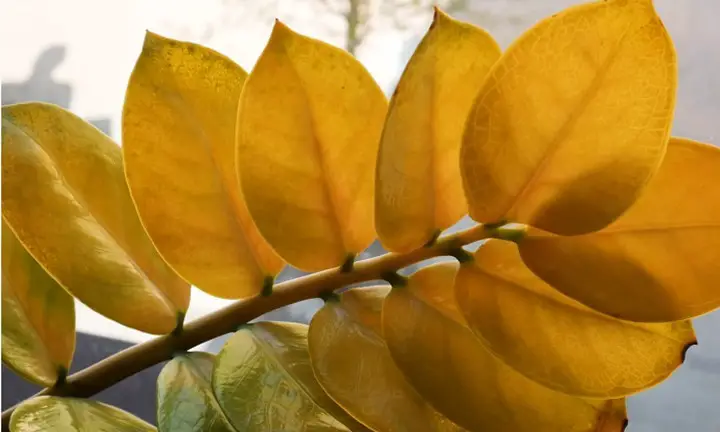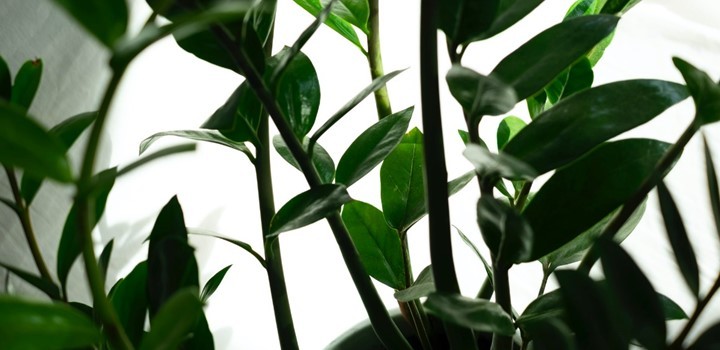ZZ plants are one of the best choices for a houseplant because they come around from any problems very easily. But the yellowing of leaves is an issue that bothers the ZZ plants a lot.
It is important to start treating them quickly because the yellow leaves will ruin the beauty of the ZZ plant as well as your house. If you can figure out the reason then it’s easy for you to solve the problem.
Now, you must be wondering “why is my ZZ plant turning yellow?”
Watering Issues, Too Much Sunlight, Extreme Temperature, Nutrient Imbalance, Pest Attack, Root Rot and, Wrong Soil are the 7 prime reasons that can turn the ZZ plants yellow.
Don’t worry! The remedy is pretty easy if you follow the right steps. In this article, I have included all the tips to ensure that your ZZ plant comes back to normal again.
So let’s get started-
Why Is My ZZ Plant Turning Yellow?

1. Improper Sunlight
ZZ Plants don’t need a lot of sunlight to thrive. Low to medium exposure to sunlight is enough for them. That’s why they make such good houseplants. So, if you expose your ZZ plants to sunlight for a long period they will turn yellow due to sunburn.
Control Measure
Now you must be thinking, does the ZZ plant need sunlight at all? Of course, they do like all other plants. 4 hours of sunlight is enough for them. But if they get more than 5 hours every day, their leaves will turn yellow with brown tips and start getting crispy.
It’s better to keep them in indirect sunlight. Keep them in a corner of your house. Hopefully, after a while, the ZZ plants will recover.
It’s good to rotate the ZZ plant every few days so the whole plant gets uniform sunlight. And this way any one side of the plant will not be exposed too much.
2. Wrong Watering
Watering can be a bit troubling if you don’t know the trick. If you water your ZZ plant the same amount as your other plant then you are making a big mistake.
ZZ plants need a very little amount of water. And they definitely don’t like to stay “wet feet”. So your ZZ plants can be turning yellow because you might be overwatering them. The leaves will also wilt and fall off from the plant.
But there’s a catch. You see, sometimes we neglect watering so much that the ZZ plant turns yellow because of underwatering. But to treat them you need to know if it’s overwatered or underwatered.
So, what does an Underwatered ZZ plant look like? Well, they turn yellow and start wilting and soon the leaves start to drop from the plant.
Control Measure
Water them only when the soil feels dry. Make sure the pot has enough holes so the water can drain freely. Otherwise, your ZZ plants will fall victim to root rot because of the constant wet soil.
Don’t let excess water under the saucer of the pot. You can replant the ZZ plants to a bigger pot with better drainage.
But don’t forget to water them once in a while. There is actually no constant schedule. You have to check the soil before watering.
But the question is how much water does the ZZ plant need?
Well, it depends on the size of the pot, temperature, humidity, sunlight, and other environmental factors. Water them once every week during summer. And once every 2 or 3 weeks in winter. You can check the soil with a moisture meter to know how much to water (Our pick: Atree Soil Soil Tester Kits with Moisture, Light, and PH Test for Garden).
3. Nutrient Imbalance
ZZ plants are amazing as houseplants because they demand very little from us. But they still need some fertilizer every once in a while.
You see, when they are grown in pots nutrient availability is very limited. And we already know that lack of nutrients can turn the leaves yellow very easily.
But the problem is if you go overboard with fertilizer then the same thing will happen. Too much fertilizer will burn the plant root and turn the leaves yellow.
Control Measure
Feed your plant once every 2 months with a water-soluble well-balanced fertilizer that is specially made for houseplants (our pick: Aquatic Arts Indoor Plant Food)
But if you already have fed the plants too much, stop feeding them for a couple of months. You can water the plant thoroughly to wash off the excess fertilizer from the roots. But be sure to drain the water quickly from the soil.
4. Extreme Temperature
ZZ plants can survive between 50°-90° Fahrenheit (10° – 32° C). But when the temperature goes below 50 °F or above 90° F, their leaves start to wilt and turn yellow.
Control Measure
Keep the ZZ plants in a warm place in this case. Regulate your room temperature within their preferable range and allow indirect sunlight to keep them warm. But do not water it more than once in 3 weeks during the cold seasons. Always keep them away from AC and radiators.
5. Pests Attack
Spider mites, scales, mealybugs suck the water and nutrients from the leaves. So, these pests are a reason why your ZZ plants are turning yellow.
The bad news is they easily attack the ZZ plants, especially in indoor conditions. If you don’t get rid of them early, they will make the plant very weak and invite other diseases. So, always keep an eye on them and look out for curled yellow leaves or webbings in your ZZ plants.
Control Measure
First, wash the plant with a strong stream of water. Then spray them with a good insecticide that’s good for houseplants (our pick: Bonide (BND951) – Systemic House Plant Insect Control)
You can also apply neem oil, horticultural oil for natural control. The recipes are given below:
#Recipe 1:- Neem Oil Recipe
Ingredients:
- Half a tablespoon of neem oil
- 1 liter of water
Steps:
- Add these ingredients together
- Spray on the ZZ plants every week
#Recipe 2:- Horticultural Oil Recipe
Ingredients:
- 1 teaspoon of liquid dishwashing soap
- 100 ml of any cooking oil like olive oil or vegetable oil
Steps:
- Add these ingredients and mix very well
- Store them as a stock mixture in a bottle
- Add 2 teaspoons of this mixture with every cup of water and pour it into the sprayer
- Spray on your ZZ plants every week
Note: Before starting to apply any homemade insecticide try it on a small leaf first. If the leaf seems okay then apply to the whole ZZ plant.
6. Root Rot
Overwatering causes root rot to the ZZ plant which is very bad for them. Because root rot is due to a fungal infection that is hard to get rid of. The plants become weak, sick, and turn yellow with a droopy appearance.
Control Measure
If you’ve watered them too much then don’t forget to check for fungal causes. So, what to do when ZZ plant leaves turn yellow due to root rot?
First, you need to check whether it’s actually root rot. For that, you need to uproot the plant and examine the roots. If the roots are soft and mushy then it confirms root rot. Cut the infected roots away carefully and replant them in fresh soil. After that apply a good fungicide according to the label directions (Our Pick: Bonide Copper Fungicide).
You can also try some homemade easy-to-make fungicides. Here are the recipes:
# Recipe 1:- Baking Soda Spray Recipe
Ingredients:
- 1 teaspoon of baking soda
- 1 teaspoon of liquid soap
- 1 liter of water
Steps:
- Mix the baking soda with water
- Then add the liquid soap
- Spray thoroughly on both sides of your ZZ plant leaves twice a week
#Recipe 2:- Vinegar Spray Recipe
Ingredients:
- 2 teaspoons of apple cider vinegar
- 1 liter of water
- Few drops of liquid dishwashing soap
Steps:
- Mix the ingredients very well
- Spray on both sides of the infected ZZ plant leaves twice a week until the problem is solved
7. Soil Problem
When the soil is damp, compact, and holds too much moisture then you will never be able to fix the yellow leaves of your ZZ plant until you change the soil. For instance, if you water them the correct amount, the wrong soil will still hold the water and injure the roots. As a result root rot will infect them.
Control Measure
Check the soil condition and if it seems to hold too much water then add some sand or change the soil with a good potting mixture used for house plants (our pick: Miracle-Gro Indoor Potting Mix)
You need to use a pot that is big enough for your ZZ plant so that the soil doesn’t put pressure on the roots. Also, make sure of enough drainage holes in them.
Frequently Asked Questions (FAQs)
Should I remove yellow leaves from the ZZ plant?
It’s good to remove the yellow leaves from the ZZ plant. It will make your plant look healthy and green and also reduce the risk of other disease infections.
Will yellow ZZ plant leaves turn green again?
Once a leaf has turned yellow, it doesn’t always turn back to green. But if the problem is fixed then some of them may turn green again.
Can I save the yellow ZZ plant?
Of course! Saving them is not that hard if you take the right actions. Water them the right amount and provide them with enough sunlight and nutrients. The ZZ plants will start to produce new green leaves
Is the ZZ plant toxic?
Yes, ZZ plants are toxic. You have to be a bit careful making sure they are out of reach of kids and pets. If anyone bites the leaves, it will make them sick.
Conclusion
A ZZ plant is one of the best choices for a houseplant. But the yellow leaves on them make them look very ugly. Though that doesn’t mean you have to throw them out. If you take a bit of care they will revive themselves very quickly.
This article will help you find out the cause and take the right actions without hurting your ZZ plants. So, just keep an eye on them and figure out what is causing them to turn yellow and help them back to a healthy plants.
